Your cart is currently empty!
Tag: English grammar
-
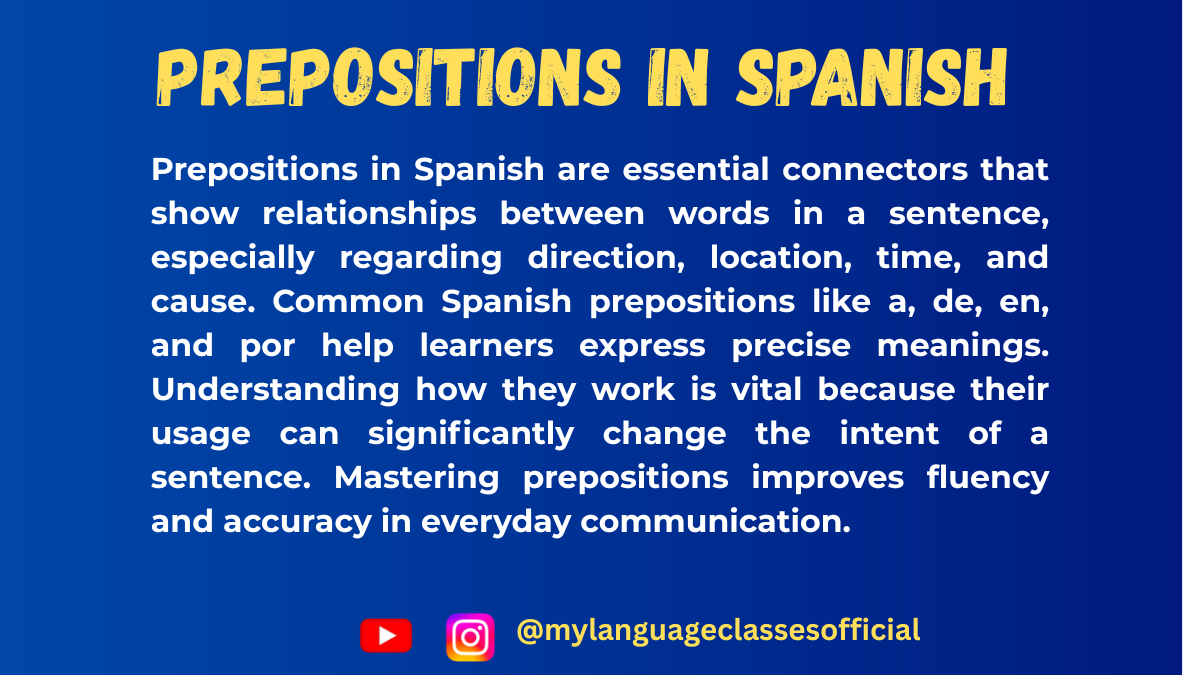
Mastering Prepositions in Spanish
Learning Spanish prepositions can seem tricky at first, but they’re essential for mastering the language. Prepositions are words that establish relationships between elements in a sentence, such as place, time, or cause. In this post, we’ll explore prepositions of place, prepositions of time, and other key types of prepositions in Spanish, with practical examples to enhance your understanding.
1. Prepositions of Place (Preposiciones de lugar)
Prepositions of place indicate the location of an object or person in relation to another. These are some of the most common:
Preposition Meaning Example en in/on/at El libro está en la mesa. (The book is on the table.) sobre on/above La lámpara está sobre la cama. (The lamp is above the bed.) bajo under/below El gato está bajo la silla. (The cat is under the chair.) entre between/among La tienda está entre el banco y la farmacia. (The store is between the bank and the pharmacy.) al lado de next to Mi casa está al lado de la escuela. (My house is next to the school.) frente a in front of El coche está frente a la casa. (The car is in front of the house.) Common Pitfall:
Learners often confuse en (in/on/at) with a (to/at). Remember:
- En emphasizes location (Estoy en casa = “I am at home”).
- A indicates motion or direction (Voy a casa = “I’m going home”).
2. Prepositions of Time (Preposiciones de tiempo)
Prepositions of time indicate when something happens. Here are key examples:
Preposition Meaning Example a at Nos vemos a las cinco. (We’ll see each other at five.) en in/on Nací en marzo. (I was born in March.) desde since/from Trabajo aquí desde 2018. (I’ve worked here since 2018.) hasta until Estaré aquí hasta las tres. (I’ll be here until three.) durante during Fuimos a España durante las vacaciones. (We went to Spain during the holidays.) Note:
The prepositions a and en often cause confusion when talking about time. For instance:
- Use a to refer to specific hours (a las siete = “at seven”).
- Use en for months, years, or periods (en abril = “in April”).
3. Other Common Prepositions
Beyond place and time, prepositions convey various relationships like cause, manner, or possession.
Preposition Meaning Example de of/from/about La casa de Juan es grande. (Juan’s house is big.) por for/because of/by Gracias por tu ayuda. (Thank you for your help.) para for/to/in order to Este regalo es para ti. (This gift is for you.) con with Voy al cine con mis amigos. (I’m going to the movies with my friends.) sin without No salgas sin paraguas. (Don’t go out without an umbrella.) Por vs. Para:
- Por often indicates a reason or means (Lo hice por amor = “I did it out of love”).
- Para suggests purpose or destination (Lo hice para ti = “I did it for you”).
4. How to Master Spanish Prepositions
- Practice with Context: Prepositions often don’t translate directly, so practice them within phrases.
- Memorize with Mnemonics: Use memory aids for tricky pairs like por and para.
- Engage in Real-Life Usage: Try journaling, speaking, or chatting with native speakers to reinforce prepositional phrases.
- Use Visual Aids: Draw diagrams to represent relationships like location (sobre = above, bajo = below).
Conclusion
Understanding and using prepositions correctly is a vital step in becoming fluent in Spanish. While their nuances may seem challenging, consistent practice and exposure will make them second nature. Whether you’re talking about the book on the table (sobre la mesa) or planning a meeting at five (a las cinco), prepositions allow you to express complex ideas with precision.
What are your biggest challenges with Spanish prepositions? Share your experiences in the comments! Let’s learn together. 😊
If you enjoyed this lesson, be sure to check out more posts like this on my blog at My Language Classes. Don’t forget to subscribe my YouTube channel and follow me on Instagram for the latest language learning tips and lessons. Leave a comment below to share your thoughts, or ask any questions you have.
Happy learning! 😊
-
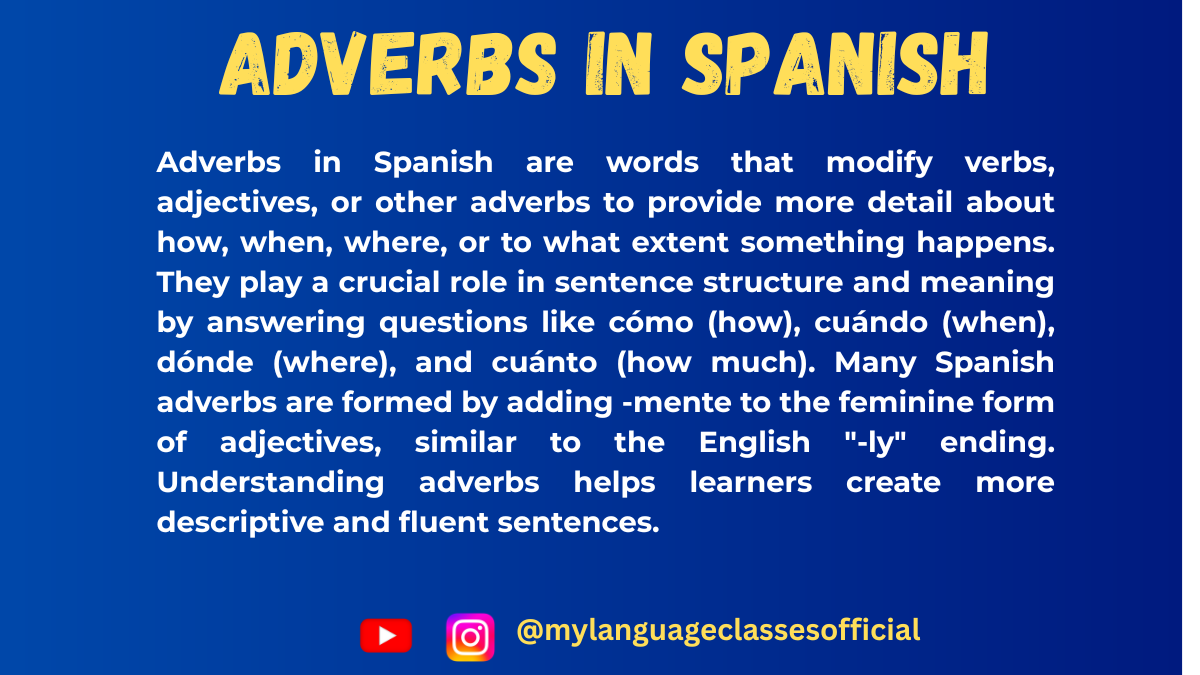
Exploring Spanish Adverbs
Adverbs are essential in Spanish, providing important details about actions—when, where, and how often they happen. Mastering adverbs will help you express yourself more clearly and accurately in everyday conversations. In this blog post, we’ll break down three important types of adverbs: adverbs of frequency, adverbs of time, and adverbs of place. Each type has its own role in enriching your sentences.
1. Adverbs of Frequency: How Often?
Adverbs of frequency tell us how often an action takes place. They are essential for describing habits, routines, and general tendencies in our daily lives. Common adverbs of frequency in Spanish include words like siempre (always) and nunca (never), which are often used to express regularity or lack thereof.
For example:
- Siempre (Always): Yo siempre tomo café por la mañana.
(I always drink coffee in the morning.) - Nunca (Never): Nunca llego tarde al trabajo.
(I never arrive late to work.)
Here’s a table summarizing common adverbs of frequency, their English meanings, and example sentences:
Adverbs of Frequency
Adverb (Spanish) English Meaning Example Sentence (Spanish) Translation (English) Siempre Always Yo siempre tomo café por la mañana. I always drink coffee in the morning. A menudo Often Ellos visitan a sus abuelos a menudo. They often visit their grandparents. Frecuentemente Frequently Los niños frecuentemente juegan en el parque. The children frequently play in the park. A veces Sometimes A veces leo libros en la biblioteca. Sometimes I read books in the library. Rara vez Rarely Ella rara vez come comida rápida. She rarely eats fast food. Nunca Never Nunca llego tarde al trabajo. I never arrive late to work. Tip: In Spanish, adverbs of frequency like siempre and nunca typically come before the verb, while others like a veces and frecuentemente can vary in position for emphasis.
2. Adverbs of Time: When?
Adverbs of time tell us when an action happens. They help us frame the timeline of a conversation, allowing us to specify moments in time—whether something happens right now, in the past, or in the future.
For example:
- Ahora (Now): Estoy estudiando ahora. (I am studying now.)
- Mañana (Tomorrow): Mañana tengo una reunión importante. (Tomorrow I have an important meeting.)
Here’s a table with some common adverbs of time and examples:
Adverbs of Time
Adverb (Spanish) English Meaning Example Sentence (Spanish) Translation (English) Ahora Now Estoy estudiando ahora. I am studying now. Hoy Today Hoy vamos al cine. Today we are going to the cinema. Mañana Tomorrow Mañana tengo una reunión importante. Tomorrow I have an important meeting. Ayer Yesterday Ayer cociné una paella deliciosa. Yesterday I cooked a delicious paella. Tarde Late Llego tarde a la clase de español. I am late for the Spanish class. Temprano Early Siempre llegamos temprano al aeropuerto. We always arrive early at the airport. Tip: When using adverbs of time, be sure to place them where they make the most sense contextually—before or after the verb depending on what you want to emphasize.
3. Adverbs of Place: Where?
Adverbs of place answer the question “Where?” These adverbs describe the location of an action. They are especially helpful in giving directions or providing specific details about where something happens. Common adverbs of place include aquí (here), allí (there), cerca (close), and lejos (far).
For example:
- Aquí (Here): Ven aquí, por favor. (Come here, please.)
- Lejos (Far): Su oficina está lejos de la estación de tren. (Their office is far from the train station.)
Here’s a table summarizing common adverbs of place:
Adverbs of Place
Adverb (Spanish) English Meaning Example Sentence (Spanish) Translation (English) Aquí Here Ven aquí, por favor. Come here, please. Allí There Dejé mis llaves allí. I left my keys there. Cerca Close/Nearby Hay un supermercado cerca de mi casa. There’s a supermarket near my house. Lejos Far Su oficina está lejos de la estación de tren. Their office is far from the train station. Dentro Inside El gato está dentro de la caja. The cat is inside the box. Fuera Outside Los niños juegan fuera. The children play outside. Tip: Adverbs of place often go after the verb, but they can sometimes appear at the beginning of the sentence for emphasis.
Final Thoughts
Adverbs are powerful tools in Spanish that help add context to your sentences. By using adverbs of frequency, adverbs of time, and adverbs of place, you can make your speech or writing much more expressive. Practice using them in different contexts, and soon they will become a natural part of your Spanish communication.
¡Buena suerte en tu aprendizaje! (Good luck with your learning!)
If you enjoyed this lesson, be sure to check out more posts like this on my blog at My Language Classes. Don’t forget to subscribe my YouTube channel and follow me on Instagram for the latest language learning tips and lessons. Leave a comment below to share your thoughts, or ask any questions you have.
Happy learning! 😊
- Siempre (Always): Yo siempre tomo café por la mañana.
-
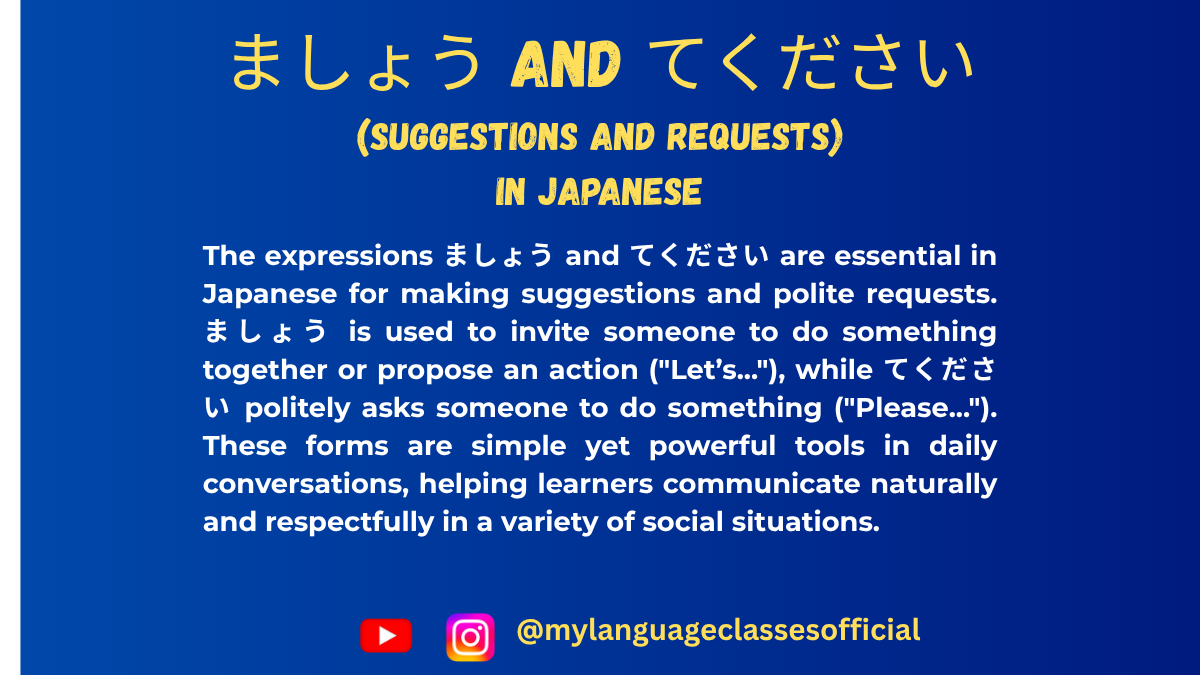
Making Suggestions and Polite Requests ましょう and てください in Japanese | My Language Classes
Mastering Polite Suggestions and Requests in Japanese
If you’re learning Japanese, understanding how to make polite suggestions and requests is a key part of effective communication. Whether you’re planning activities with friends or politely asking for help, two common expressions—Verb stem + ましょう and Verb stem + てください—are your go-to tools. Let’s dive into their usage, including how to form them step by step.
1. Making Suggestions with ましょう (mashou): “Let’s [verb]”
The expression ましょう is a polite and versatile way to suggest an activity or propose an idea. It carries a collaborative tone, meaning “Let’s do [verb].”
How to Form the ましょう Form
Japanese verbs are divided into three groups, and the method for creating the ましょう form depends on the group.
Group 1: U-Verbs (Godan Verbs)
- Start with the stem of the verb (remove the u-ending).
- Replace the u sound with the i sound.
- Add ましょう.
Verb Stem Change to i Form Add ましょう Example Translation 行く 行 行き 行きましょう Let’s go. 書く 書 書き 書きましょう Let’s write. 話す 話 話し 話しましょう Let’s talk.
Group 2: Ru-Verbs (Ichidan Verbs)
- Remove the final る.
- Add ましょう.
Verb Stem Add ましょう Example Translation 食べる 食べ 食べましょう Let’s eat. 見る 見 見ましょう Let’s look.
Group 3: Irregular Verbs
There are two irregular verbs, and their ましょう forms are as follows:
Verb Change to Stem Add ましょう Example Translation する し しましょう Let’s do it. 来る (kuru) 来 (ki) 来ましょう Let’s come.
When to Use ましょう
- Planning with others:
Example: 公園へ行きましょう!(Kōen e ikimashou!) = Let’s go to the park! - Encouraging teamwork:
Example: 一緒に勉強しましょう。(Issho ni benkyou shimashou.) = Let’s study together.
The tone is polite, making it suitable for formal and casual settings, as long as it’s a group-oriented activity.
2. Making Requests with てください (tekudasai): “Please [verb]”
Before diving into てください, we need to understand how to form the te-form of verbs. The te-form is one of the most fundamental conjugations in Japanese grammar and is used in various contexts beyond requests, such as making commands, linking actions, and creating the polite request structure てください.
How to Make the Te-Form
Japanese verbs are categorized into three groups, and the rules for forming the te-form differ depending on the group.
Group 1: U-Verbs (Godan Verbs)
For verbs ending in う, つ, る, む, ぶ, ぬ, く, ぐ, す, follow these rules:
- Replace the final u-sound with its corresponding te-form sound:
Ending Te-Form Rule Example う Replace with って 買う (kau) → 買って (katte) = Buy つ Replace with って 立つ (tatsu) → 立って (tatte) = Stand る Replace with って 取る (toru) → 取って (totte) = Take む Replace with んで 読む (yomu) → 読んで (yonde) = Read ぶ Replace with んで 遊ぶ (asobu) → 遊んで (asonde) = Play ぬ Replace with んで 死ぬ (shinu) → 死んで (shinde) = Die く Replace with いて 書く (kaku) → 書いて (kaite) = Write ぐ Replace with いで 泳ぐ (oyogu) → 泳いで (oyoide) = Swim す Replace with して 話す (hanasu) → 話して (hanashite) = Speak
Group 2: Ru-Verbs (Ichidan Verbs)
For verbs ending in る, simply drop る and add て:
- 食べる (taberu) → 食べて (tabete) = Eat.
- 見る (miru) → 見て (mite) = Look.
Group 3: Irregular Verbs
There are only two irregular verbs in Japanese:
- する → して = Do.
Example: 勉強する (benkyou suru) → 勉強して (benkyou shite) = Study. - 来る (kuru) → 来て (kite) = Come.
Forming てください
Once you have the te-form of a verb, simply add ください to make a polite request:
- 見る (miru) → 見て (mite) + ください = 見てください (mite kudasai) = Please look.
- 書く (kaku) → 書いて (kaite) + ください = 書いてください (kaite kudasai) = Please write.
- 手伝う (tetsudau) → 手伝って (tetsudatte) + ください = 手伝ってください (tetsudatte kudasai) = Please help.
When to Use It
- Asking politely:
Example: ちょっと待ってください。(Chotto matte kudasai.) = Please wait a moment. - Giving instructions:
Example: ドアを閉めてください。(Doa o shimete kudasai.) = Please close the door.
This phrase is polite and commonly used in both formal and informal situations.
Key Differences Between ましょう and てください
Expression Purpose Tone Verb stem + ましょう Suggestion: “Let’s do [verb]” Collaborative and inclusive Verb stem + てください Request: “Please do [verb]” Respectful and polite
Quick Practice: Try It Out!
Let’s put these into practice. Can you guess the correct form for each scenario?
- You’re suggesting to a friend: “Let’s watch a movie.”
Hint: The verb is 見る (miru).
Answer: 映画を見ましょう!(Eiga o mimashou!) - You’re asking someone politely: “Please listen to me.”
Hint: The verb is 聞く (kiku).
Answer: 私の話を聞いてください。(Watashi no hanashi o kiite kudasai.)
Conclusion
Mastering ましょう and てください opens up a world of polite and smooth communication in Japanese. By understanding these structures—and learning how to form the te-form and ましょう—you can make suggestions, request actions, and navigate various social situations with confidence. Practice them in your daily conversations, and soon they’ll become second nature!
What are your favorite phrases using ましょう or てください? Share them in the comments below! Or, if you have any questions about Japanese grammar, feel free to ask. Let’s keep learning together—日本語を楽しみましょう!(Nihongo o tanoshimimashou!) 😊
If you enjoyed this lesson, be sure to check out more posts like this on my blog at My Language Classes. Don’t forget to subscribe my YouTube channel and follow me on Instagram for the latest language learning tips and lessons. Leave a comment below to share your thoughts, or ask any questions you have about nouns.
Happy learning! 😊
-

Learn How to Use Gustar and Similar Spanish Verbs
When learning Spanish, one of the trickiest yet most fascinating parts of the language is understanding how verbs like gustar work. These verbs don’t follow the typical subject-verb-object structure we’re used to in English. Instead, they flip the script—placing the person or thing we like (or love, or find interesting) at the forefront of the sentence. In this blog post, we’ll break down gustar and similar verbs like encantar and interesar so you can use them like a native speaker.
Understanding the Structure of Gustar
Let’s start with the basics. The verb gustar translates to “to like,” but it literally means “to be pleasing to.” This difference in meaning is key to mastering it. Here’s how it works:
- Indirect object pronoun + verb + subject.
- Me gusta el chocolate. (Chocolate is pleasing to me.)
- Nos gustan los libros. (The books are pleasing to us.)
- El libro me gusta. (singular)
- Los libros me gustan. (plural)
Indirect Object Pronouns
The indirect object pronouns are essential in these constructions because they indicate to whom something is pleasing:
Pronoun English Equivalent Me To me Te To you (informal) Le To him/her/you (formal) Nos To us Os To you all (informal, Spain) Les To them/you all For example:
- Te gusta bailar. (Dancing is pleasing to you.)
- Les gustan las películas. (The movies are pleasing to them.)
Expanding Beyond Gustar: Encantar and Interesar
Now that you’ve got the hang of gustar, you can easily apply this structure to similar verbs like encantar (to love), interesar (to be interested in), and others.
Encantar (To Love)
Use encantar to express stronger emotions, like loving something (but not romantically):
- Me encanta la música clásica. (I love classical music.)
- ¿Te encantan los animales? (Do you love animals?)
Interesar (To Be Interested In)
Use interesar to talk about interests or curiosities:
- Nos interesa la historia. (We are interested in history.)
- ¿Te interesan los deportes? (Are you interested in sports?)
Other Verbs Like Gustar
Here’s a quick list of other verbs that follow the same pattern:
- Fascinar: to fascinate
- Le fascinan los aviones. (Airplanes fascinate him/her.)
- Molestar: to bother
- Nos molesta el ruido. (The noise bothers us.)
- Importar: to matter, to be important
- ¿Te importa si abro la ventana? (Do you mind if I open the window?)
- Quedar: to have left
- Me quedan cinco dólares. (I have five dollars left.)
Common Mistakes to Avoid
- Using the wrong pronoun: Always match the indirect object pronoun with the person who feels the emotion, not the subject.
- Incorrect: Yo gusto los perros. (This means I am pleasing to dogs.)
- Correct: Me gustan los perros. (I like dogs.)
- Forgetting verb agreement: Make sure the verb matches the subject in number.
- Incorrect: Me gusta los libros.
- Correct: Me gustan los libros. (I like the books.)
- Literal translations: Remember, gustar doesn’t mean “to like” in a direct way. Think of it as “to be pleasing to” to grasp the Spanish logic.
Practice Makes Perfect
Here are some sentences for you to practice. Fill in the blanks with the correct form of the verb and pronoun:
- A mí _______ (encantar) las flores en primavera.
- ¿A ti _______ (interesar) el arte moderno?
- A ellos no _______ (gustar) la comida picante.
- A nosotros _______ (molestar) el ruido de la calle.
Final Thoughts
Verbs like gustar give Spanish its charm and unique flair. By understanding their structure and practicing regularly, you’ll unlock a whole new way of expressing yourself. Don’t be afraid to make mistakes—language learning is all about experimenting. ¡Buena suerte!
What’s your favorite gustar-style verb? Share your examples in the comments below!
If you enjoyed this lesson, be sure to check out more posts like this on my blog at My Language Classes. Don’t forget to subscribe my YouTube channel and follow me on Instagram for the latest language learning tips and lessons. Leave a comment below to share your thoughts, or ask any questions you have.
Happy learning! 😊
- Indirect object pronoun + verb + subject.
-
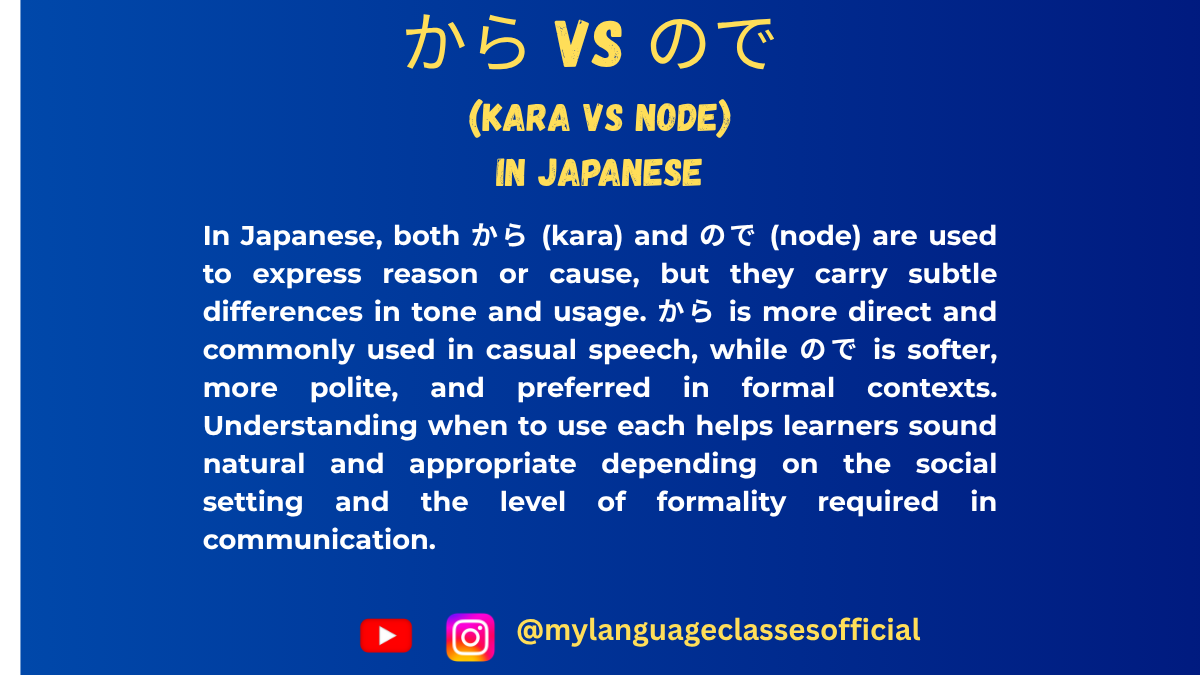
How to Say “Because” in Japanese から (kara) vs. ので (node) | My Language Classes
Expressing “Because” in Japanese: から (kara) vs. ので (node)
When learning Japanese, understanding how to express “because” is essential for forming logical connections in your sentences. Two primary tools for this are から (kara) and ので (node). Both translate roughly to “because” or “since,” but their nuances and appropriate contexts differ. In this post, we’ll explore their meanings, usage, and subtle differences to help you master them.
1. Understanding から (kara)
から is a versatile and commonly used particle to indicate cause and effect. Its usage is straightforward and can be found in both casual and formal contexts, though it often leans more casual.
Structure:
- Reason + から + Result
- Example: 勉強しなかったから、試験に落ちました。
(Benkyou shinakatta kara, shiken ni ochimashita.)
“Because I didn’t study, I failed the exam.”
- Example: 勉強しなかったから、試験に落ちました。
Key Features:
- Direct and Conversational:
から is widely used in everyday speech. It gives a clear and sometimes blunt explanation of reasons.- Example: 雨が降っているから、外に行きません。
(Ame ga futteiru kara, soto ni ikimasen.)
“Because it’s raining, I won’t go outside.”
- Example: 雨が降っているから、外に行きません。
- Flexible Placement:
You can use から in both written and spoken Japanese, though it feels more natural in informal contexts. - Focus on the Speaker’s Perspective:
The reason expressed with から often reflects the speaker’s opinion or justification.
2. Understanding ので (node)
ので is another way to express “because,” but it has a softer, more polite tone. It’s commonly used in formal situations or when you want to sound less direct or imposing.
Structure:
- Reason + ので + Result
- Example: 雨が降っているので、外に行きません。
(Ame ga futteiru node, soto ni ikimasen.)
“Since it’s raining, I won’t go outside.”
- Example: 雨が降っているので、外に行きません。
Key Features:
- Polite and Subtle:
ので carries a sense of consideration, making it ideal for formal or respectful conversations.- Example: お腹が空いたので、何か食べましょう。
(Onaka ga suita node, nanika tabemashou.)
“Since I’m hungry, let’s eat something.”
- Example: お腹が空いたので、何か食べましょう。
- Softer Implications:
Compared to から, ので feels less assertive and more explanatory. It’s often used when the reason is more objective or when you’re asking for understanding. - Common in Formal Writing and Speech:
You’ll frequently see ので in polite correspondence, workplace conversations, and when addressing superiors.
3. Key Differences Between から and ので
Aspect から ので Tone Direct, casual Polite, formal, soft Usage Everyday conversations Formal writing and respectful speech Reason Type Subjective or personal Objective or neutral Politeness Level Casual to neutral Neutral to polite Examples Highlighting the Differences:
- Casual Statement:
- 勉強しなかったから、試験に落ちた。 (Benkyou shinakatta kara, shiken ni ochita.)
“I failed the exam because I didn’t study.” (Direct and casual) - 勉強しなかったので、試験に落ちました。 (Benkyou shinakatta node, shiken ni ochimashita.)
“I failed the exam since I didn’t study.” (Polite and explanatory)
- 勉強しなかったから、試験に落ちた。 (Benkyou shinakatta kara, shiken ni ochita.)
- Polite Request:
- 道が混んでいたから、遅れました。 (Michi ga kondeita kara, okuremashita.)
“I was late because the roads were crowded.” (Blunt explanation) - 道が混んでいたので、遅れました。 (Michi ga kondeita node, okuremashita.)
“I was late since the roads were crowded.” (Polite and considerate)
- 道が混んでいたから、遅れました。 (Michi ga kondeita kara, okuremashita.)
4. When to Use Which?
Use から When:
- Speaking casually with friends or family.
- Explaining personal reasons directly.
- Adding emphasis to the cause-effect relationship.
Use ので When:
- Communicating in formal or polite settings.
- Writing formal letters, essays, or workplace emails.
- Explaining reasons with a softer tone to avoid sounding blunt.
5. A Quick Note on Grammar
- から connects to the plain form of a verb, adjective, or noun:
- Verb: 走るから (Hashiru kara, “Because I run”)
- Adjective: 寒いから (Samui kara, “Because it’s cold”)
- Noun + だ: 先生だから (Sensei da kara, “Because I’m a teacher”)
- ので also connects to the plain form, but nouns and な-adjectives require な before ので:
- Verb: 走るので (Hashiru node, “Since I run”)
- Adjective: 寒いので (Samui node, “Since it’s cold”)
- Noun + な: 先生なので (Sensei na node, “Since I’m a teacher”)
6. Practice Makes Perfect!
Understanding から and ので is only the beginning. Try using them in sentences to express reasons for daily activities. For example:
- 電車が遅れたから、会議に間に合いませんでした。
(Densha ga okureta kara, kaigi ni ma ni aimasendeshita.)
“Because the train was delayed, I couldn’t make it to the meeting.” - 電車が遅れたので、会議に間に合いませんでした。
(Densha ga okureta node, kaigi ni ma ni aimasendeshita.)
“Since the train was delayed, I couldn’t make it to the meeting.”
By practicing these expressions in context, you’ll develop an intuitive sense of when to use から and ので, enhancing both your fluency and sensitivity to Japanese communication styles. Keep practicing, and don’t hesitate to mix them into your conversations!
If you enjoyed this lesson, be sure to check out more posts like this on my blog at My Language Classes. Don’t forget to subscribe my YouTube channel and follow me on Instagram for the latest language learning tips and lessons. Leave a comment below to share your thoughts, or ask any questions you have about nouns.
Happy learning! 😊
- Reason + から + Result
-
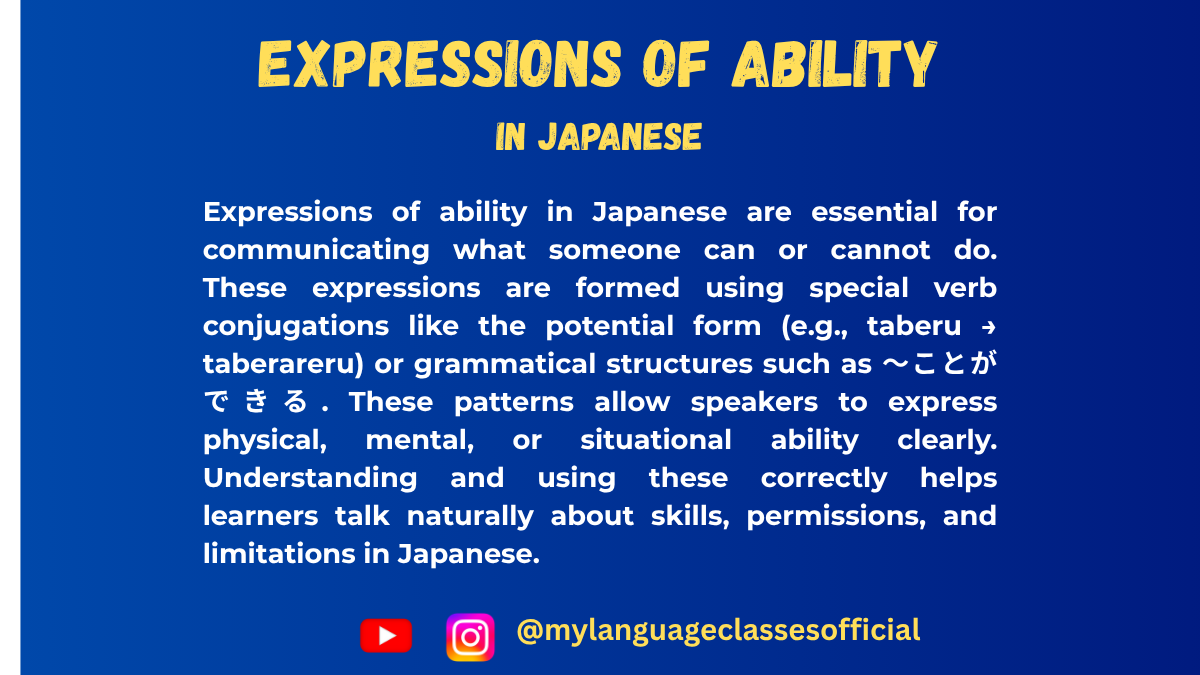
Understanding Ability in Japanese | My Language Classes
Mastering the Expressions of Ability in Japanese
When learning Japanese, expressing ability—your capacity to “do” something—is a crucial skill. In this post, we’ll delve into one of the most common ways to express “can” in Japanese: using ことができる (koto ga dekiru). Along the way, we’ll also explore the potential form of verbs, explaining what it is, how it’s formed, and when to use it. Let’s get started!
Understanding ことができる
The phrase ことができる translates roughly to “can do” or “be able to do.” It’s a versatile structure that allows you to express ability in relation to a wide range of actions. Here’s a breakdown of its components:
- こと: A nominalizer that turns verbs into nouns. For instance, “to speak” (話す, hanasu) becomes “the act of speaking” (話すこと, hanasu koto).
- が: The particle marking the subject of the ability.
- できる: The verb meaning “can do” or “to be able to do.”
Basic Formula:
Verb (Dictionary Form) + ことができる
Examples:
- 日本語を話すことができる
(Nihongo o hanasu koto ga dekiru)
“I can speak Japanese.” - ピアノを弾くことができる
(Piano o hiku koto ga dekiru)
“I can play the piano.” - 友達と旅行することができる
(Tomodachi to ryokou suru koto ga dekiru)
“I can travel with my friends.”
Using できる as a Standalone Verb
Did you notice that できる itself can also stand alone? It translates simply as “can do” and is often paired with a noun:
- テニスができる
(Tenisu ga dekiru)
“I can play tennis.” - 宿題ができる
(Shukudai ga dekiru)
“I can do homework.”
This usage avoids the ことが entirely, but the meaning remains similar.
What is the Potential Form?
The potential form of a verb is another way to express “can” or “ability to do something” in Japanese. Unlike ことができる, the potential form is built directly into the verb itself. It’s widely used in casual speech due to its simplicity and brevity.
When to Use the Potential Form
The potential form is ideal for situations where:
- Informality is key: It’s more conversational than ことができる.
- Directness is preferred: Instead of a multi-word structure, the potential form is compact and to the point.
How to Form the Potential Form
The way you form the potential form depends on the type of verb:
1. Group 1 Verbs (U-verbs)
For U-verbs, change the final -u sound of the dictionary form to its corresponding -eru sound.
Example:
- 話す (hanasu, “to speak”) → 話せる (hanaseru, “can speak”)
- 書く (kaku, “to write”) → 書ける (kakeru, “can write”)
- 泳ぐ (oyogu, “to swim”) → 泳げる (oyogeru, “can swim”)
2. Group 2 Verbs (Ru-verbs)
For Ru-verbs, simply replace the final -ru with -rareru.
Example:
- 食べる (taberu, “to eat”) → 食べられる (taberareru, “can eat”)
- 見る (miru, “to see”) → 見られる (mirareru, “can see”)
3. Irregular Verbs
There are only two irregular verbs to remember:
- する (“to do”) → できる (“can do”)
- 来る (kuru, “to come”) → 来られる (korareru, “can come”)
Examples of the Potential Form:
- 日本語が話せる
(Nihongo ga hanaseru)
“I can speak Japanese.” - ピアノが弾ける
(Piano ga hikeru)
“I can play the piano.” - 友達と旅行できる
(Tomodachi to ryokou dekiru)
“I can travel with my friends.”
Potential Form vs. ことができる
While both methods express ability, they have distinct nuances:
- ことができる: More formal and suitable for writing or polite contexts.
- Example: 日本語を話すことができる
- Potential Form: Shorter and more conversational.
- Example: 日本語が話せる
The Negative Forms
For both ことができる and the potential form, negation is straightforward:
- ことができない: “Cannot do.”
- Example: 日本語を話すことができない
- Potential form (negative): Replace the final -eru or -rareru with -enai or -rarenai.
- Example: 日本語が話せない
Politeness Levels
Japanese offers ways to adjust politeness. Here’s how to modify each form:
- ことができます: Polite version of ことができる.
- Potential Form (Polite): Add -ます to the potential form.
- Example: 話せます (hanasemasu, “can speak”).
Practice Makes Perfect
Let’s end with some practice sentences. Try translating these into Japanese:
- “I can read kanji.”
- “I cannot eat sushi.”
- “I can go to Japan next year.”
(Answers: 1. 漢字を読むことができる / 漢字が読める, 2. 寿司を食べることができない / 寿司が食べられない, 3. 来年日本に行くことができる / 来年日本に行ける)
Final Thoughts
Understanding how to use ことができる and the potential form unlocks a world of possibilities for expressing your abilities in Japanese. Whether you’re aiming for formal precision or casual brevity, practicing these structures will help you sound more natural and confident.
Have questions or want to share your examples? Comment below! 😊
If you enjoyed this lesson, be sure to check out more posts like this on my blog at My Language Classes. Don’t forget to subscribe my YouTube channel and follow me on Instagram for the latest language learning tips and lessons. Leave a comment below to share your thoughts, or ask any questions you have about nouns.
Happy learning! 😊
-
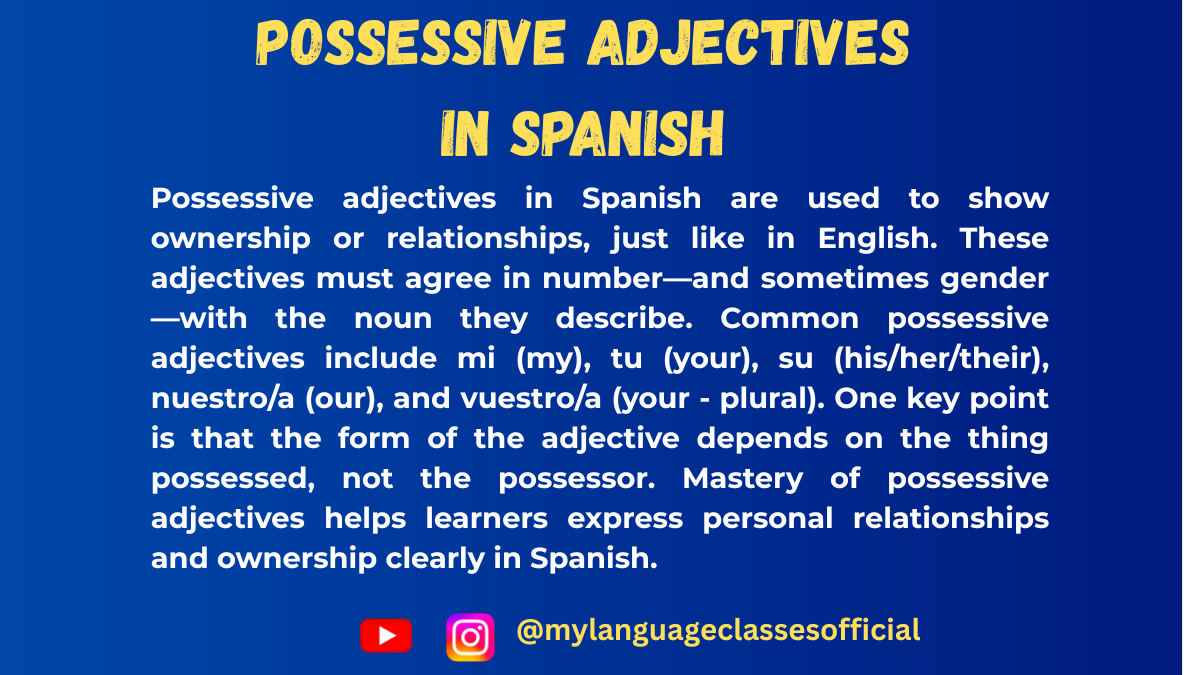
Mastering Possessive Adjectives in Spanish
¡Hola, amigos! If you’re diving into the beautiful world of Spanish, understanding possessive adjectives is a must. These small but powerful words allow you to express ownership and connection, and they’re used all the time in daily conversation. As an expert Spanish teacher and YouTuber, I’m here to break them down for you in a way that’s easy to understand. Let’s get started!
What Are Possessive Adjectives?
Possessive adjectives in Spanish are words that indicate to whom something belongs. Unlike English, Spanish possessive adjectives agree in gender and number with the noun they describe. Here are the main ones you’ll need to know:
Singular Possession Plural Possession mi (my) mis (my) tu (your, informal) tus (your, informal) su (his, her, its, your, formal) sus (his, her, its, your, formal) nuestro/a (our) nuestros/as (our) vuestro/a (your, informal Spain) vuestros/as (your, informal Spain) su (their, your, formal) sus (their, your, formal)
Key Characteristics of Possessive Adjectives
- Agree with the Noun, Not the Owner
In Spanish, possessive adjectives match the gender and number of the noun they describe, not the person who owns the object. For example:- Mi libro (My book) → Mis libros (My books)
- Nuestro coche (Our car) → Nuestra casa (Our house)
- Informal vs. Formal “Your”
- Use tu/tus for informal situations (talking to friends, family, etc.).
- Use su/sus for formal situations (talking to strangers, superiors, etc.).
- “Vuestro” is Only Used in Spain
If you’re in Spain, you’ll hear vuestro/vuestra/vuestros/vuestras for “your” in informal plural situations. In Latin America, people stick to su/sus for both formal and informal plural forms.
Examples in Everyday Context
1. Mi/Mis
- Mi casa es tu casa. (My house is your house.)
- Mis amigos son increíbles. (My friends are amazing.)
2. Tu/Tus
- ¿Dónde está tu teléfono? (Where is your phone?)
- Tus ideas son brillantes. (Your ideas are brilliant.)
3. Su/Sus
- Su coche es rápido. (His/her/your car is fast.)
- Sus libros están en la mesa. (His/her/your books are on the table.)
4. Nuestro/Nuestra/Nuestros/Nuestras
- Nuestro perro es muy lindo. (Our dog is very cute.)
- Nuestras familias están cenando juntas. (Our families are having dinner together.)
5. Vuestro/Vuestra/Vuestros/Vuestras
- ¿Es vuestro jardín? (Is this your garden?) [Used in Spain]
- Vuestras mochilas están aquí. (Your backpacks are here.) [Used in Spain]
Common Mistakes and How to Avoid Them
- Forgetting Gender Agreement
Beginners often forget to match the possessive adjective to the noun’s gender. Remember:- Nuestra for feminine singular (nuestra casa).
- Nuestro for masculine singular (nuestro coche).
- Mixing Formal and Informal “You”
- Don’t confuse tu (your) with tú (you).
- Example: Tu libro está aquí, tú lo olvidaste. (Your book is here; you forgot it.)
- Using the Wrong Plural Form
Always use the plural form of the possessive when describing multiple items:- Correct: Mis zapatos están en la entrada. (My shoes are at the entrance.)
- Incorrect: Mi zapatos están en la entrada.
Tips for Mastering Possessive Adjectives
- Practice with Real-Life Contexts
Try labeling items around your home. For example: mi teléfono, tu lámpara, su silla. - Listen and Repeat
Watch Spanish YouTube videos or listen to podcasts. Pay attention to how native speakers use these adjectives in context. - Interactive Exercises
Create sentences with different possessive adjectives and have a friend or teacher check them. For example:- Mi madre cocina muy bien. (My mother cooks very well.)
- ¿Dónde están tus llaves? (Where are your keys?)
- Create a Song or Mnemonic
Memorizing can be fun! Make a short song with the possessive adjectives or a catchy rhyme.
Final Thoughts
Mastering mi, tu, su, nuestro, vuestro is an important step in your Spanish-learning journey. With consistent practice and exposure, you’ll use them naturally in no time. ¡Buena suerte y sigue practicando! (Good luck and keep practicing!)
If you enjoyed this lesson, be sure to check out more posts like this on my blog at My Language Classes. Don’t forget to subscribe my YouTube channel and follow me on Instagram for the latest language learning tips and lessons. Leave a comment below to share your thoughts, or ask any questions you have.
Happy learning! 😊
- Agree with the Noun, Not the Owner
